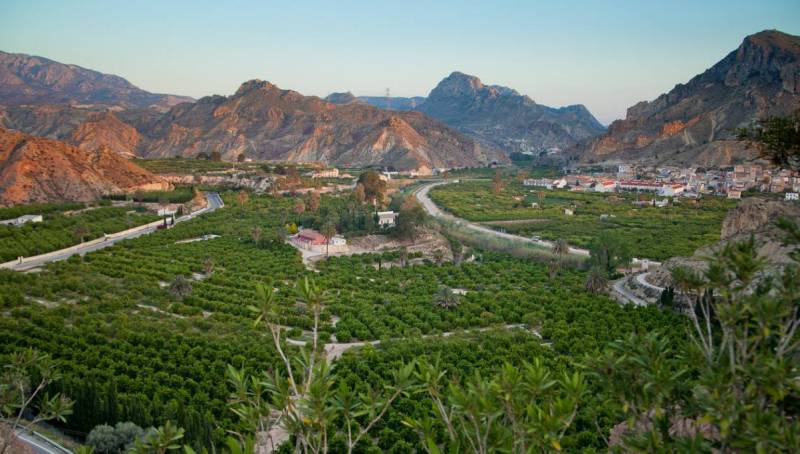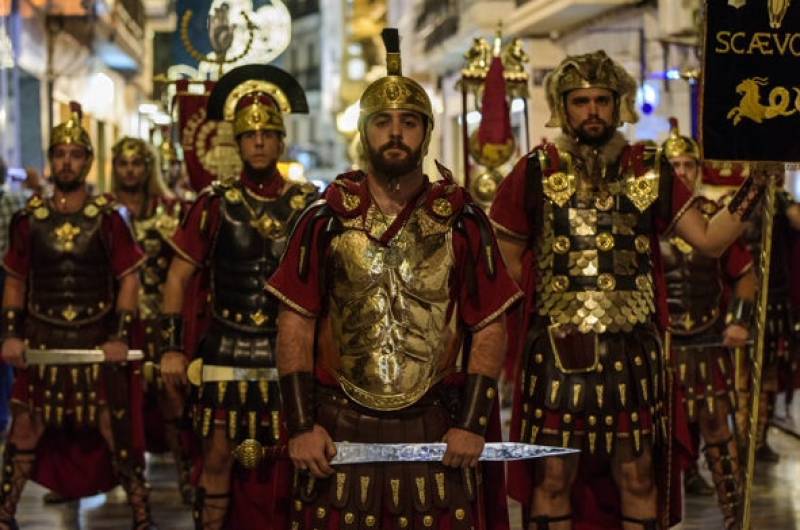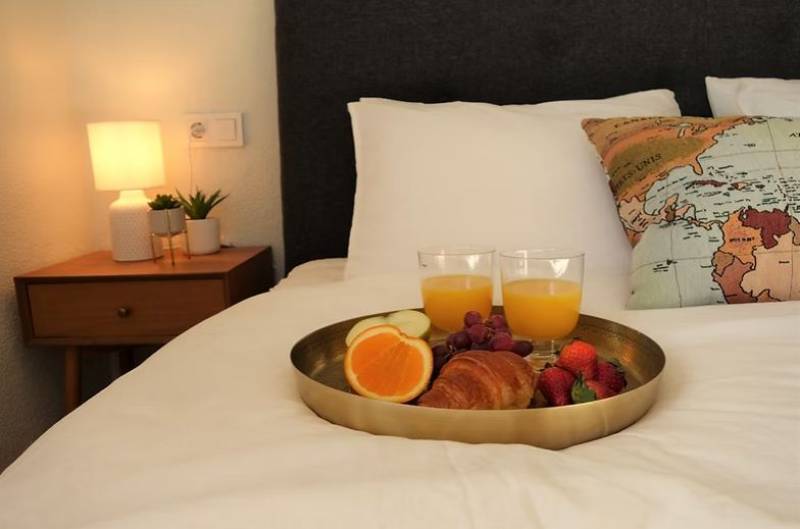- Region
- Águilas
- Alhama de Murcia
- Jumilla
- Lorca
- Los Alcázares
- Mazarrón
- San Javier
-
ALL AREAS & TOWNS
- AREAS
- SOUTH WEST
- MAR MENOR
- MURCIA CITY & CENTRAL
- NORTH & NORTH WEST
- TOWNS
- Abanilla
- Abarán
- Aguilas
- Alamillo
- Alcantarilla
- Aledo
- Alhama de Murcia
- Archena
- Balsicas
- Blanca
- Bolnuevo
- Bullas
- Cañadas del Romero
- Cabo de Palos
- Calasparra
- Camping Bolnuevo
- Campo De Ricote
- Camposol
- Canada De La Lena
- Caravaca de la Cruz
- Cartagena
- Cehegin
- Ceuti
- Cieza
- Condado de Alhama
- Corvera
- Costa Cálida
- Cuevas De Almanzora
- Cuevas de Reyllo
- El Carmoli
- El Mojon
- El Molino (Puerto Lumbreras)
- El Pareton / Cantareros
- El Raso
- El Valle Golf Resort
- Fortuna
- Fuente Alamo
- Hacienda del Alamo Golf Resort
- Hacienda Riquelme Golf Resort
- Isla Plana
- Islas Menores & Mar de Cristal
- Jumilla
- La Azohia
- La Charca
- La Manga Club
- La Manga del Mar Menor
- La Pinilla
- La Puebla
- La Torre
- La Torre Golf Resort
- La Unión
- Las Palas
- Las Ramblas
- Las Ramblas Golf
- Las Torres de Cotillas
- Leiva
- Librilla
- Lo Pagan
- Lo Santiago
- Lorca
- Lorquí
- Los Alcázares
- Los Balcones
- Los Belones
- Los Canovas
- Los Nietos
- Los Perez (Tallante)
- Los Urrutias
- Los Ventorrillos
- Mar De Cristal
- Mar Menor
- Mar Menor Golf Resort
- Mazarrón
- Mazarrón Country Club
- Molina de Segura
- Moratalla
- Mula
- Murcia City
- Murcia Property
- Pareton
- Peraleja Golf Resort
- Perin
- Pilar de la Horadada
- Pinar de Campoverde
- Pinoso
- Playa Honda
- Playa Honda / Playa Paraíso
- Pliego
- Portmán
- Pozo Estrecho
- Puerto de Mazarrón
- Puerto Lumbreras
- Puntas De Calnegre
- Region of Murcia
- Ricote
- Roda Golf Resort
- Roldan
- Roldan and Lo Ferro
- San Javier
- San Pedro del Pinatar
- Santiago de la Ribera
- Sierra Espuña
- Sucina
- Tallante
- Terrazas de la Torre Golf Resort
- Torre Pacheco
- Totana
- What's On Weekly Bulletin
- Yecla


- EDITIONS:
 Spanish News Today
Spanish News Today
 Alicante Today
Alicante Today
 Andalucia Today
Andalucia Today
Cabo de Palos, visiting the lighthouse and marina area, a great ride out for bikers
Where to go Mar Menor, walk up to the lighthouse at Cabo de Palos or enjoy an ice cream in the busy marina
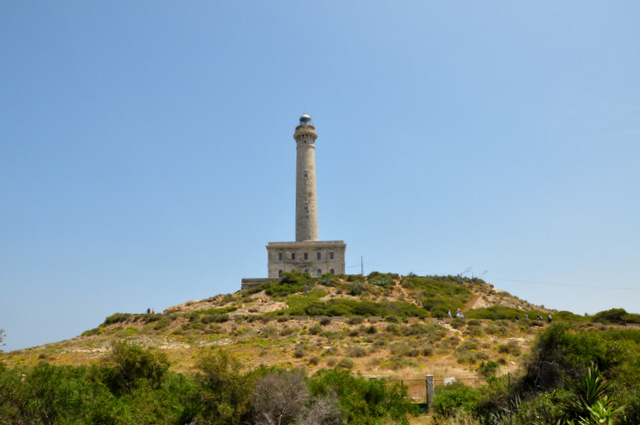
Cabo de Palos is a small peninsula which juts out into the Mediterranean sea, on one side stretching out along unspoilt coastline towards Cartagena, and on the other fusing with the spit of land known as La Manga. This is the thin strip of land which encloses the Mar Menor, Europe's largest saltwater lagoon and a mecca for water sports enthusiasts, its shallow sand-fringed waters and winds creating superb sailing conditions and safe training grounds.
The peninsula itself was formed during volcanic eruptions, as were the islands close by, and this creates a unique eco-system which gives the Cabo de Palos area a reputation as being one of the best diving sites in Europe.
Looking at Cabo de Palos on an aerial photo, fine lines of rocks can clearly be seen linking the islands which lie offshore. These create an almost enclosed area which has been declared a wildlife reserve, the Islas Hormigas reserve, but also make the area extremely dangerous for shipping to navigate as shelves, gulleys and rock formations rise to within 3 metres of the surface.
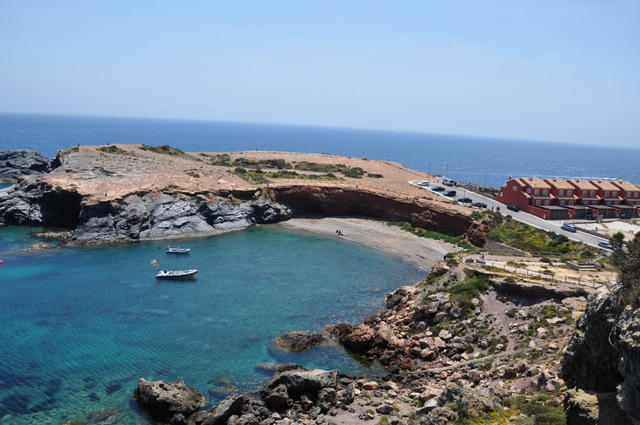
The danger these rocks present to shipping necessitated the creation of the lighthouse which sits atop the peninsula today forms a perfect focal point for a visit to the area, giving magnificent views across the surrounding countryside as well as being an imposing structure in its own right.
Allied with some beautiful secluded beaches, superb snorkeling, an attractive and busy marina with comfortable seating areas to observe marine traffic and a range of excellent bars and restaurants serving locally caught fish, tapas or ice creams, the lighthouse of Cabo de Palos can be the highlight of an interesting trip out or a day on the beach.
Location: The lighthouse itself is at the tip of the peninsula, marked Cabo de Palos, Click Cabo de Palos for map.
A bit of history
This area has been occupied by mankind since humans first began to appear on mainland Europe, 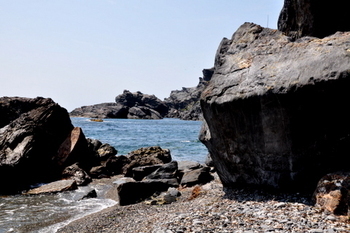 and there are several sites around the the Mar Menor which have yielded rich remains of the early humans, and indeed the Neanderthals who lived and hunted in Torre Pacheco nearby.
and there are several sites around the the Mar Menor which have yielded rich remains of the early humans, and indeed the Neanderthals who lived and hunted in Torre Pacheco nearby.
The earliest written records of Cabo de Palos appear in the texts of Pliny the Elder and Rufus Festus Aurelius, both of whom report that on the site now occupied by the lighthouse there was once a temple dedicated to the God Baal Hammon, Lord of the two horns.
Baal was the god of fertility and was worshipped by the Carthaginians who occupied what is now Cartagena. They inhabited the area before the Roman occupation, around 250BC, and were engaged in constant conflict with the Romans for control of the lucrative Mediterranean shipping routes, two notable periods of direct conflict being the Punic Wars, the Romans pushing them further and further along the coast and out along the edges of Africa and along the coasts of southern Spain. Once an immensely powerful trading nation, their influence finally waned, and Cartagena was overrun after Hannibal, who actually lived in Cartagena and may well have worshipped at this very temple, set out across the Alps with his 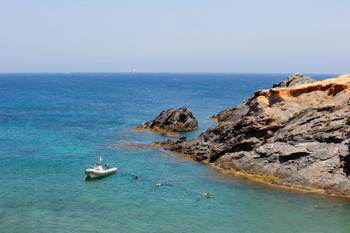 elephants, leaving the city vulnerable to the Romans who invaded it in 210 BC.
elephants, leaving the city vulnerable to the Romans who invaded it in 210 BC.
Baal's partner was the goddess Tanit, and each year she is evoked in a ceremony which takes place in the Romans and Carthaginians fiestas, one of the most colourful and exciting in the region, at the end of September.
The Romans had their own gods, so the temple was turned over to the worship of Saturn, the Roman god of agriculture, justice and strength, and an imposing place it must have been, set high on the rocky point, priests lighting the fires which nourished and fed it.
There is no trace today of the temple, and no further written records exist until in the mid-16th century when King Philip II of Spain ordered the construction of a watch-tower to alert inhabitants of the surrounding countryside when Berber pirates approached the coastline.
These historical facts are still brought to life every year in the local fiestas of the Berber invasions, or "incursions" as they are known here, which take place the week following Easter in Los Alcázares. The Berber raiders from northern Africa were a real problem along this coastline, raiding and kidnapping, stealing flocks and crops and taking local people hostage or selling the ones with no ransom value in Arab slave markets.
As late as 1815 there are still records of pirate attacks, a famous battle between US and  Algerian naval forces taking place in what is known as the Second Berbery war. In the Battle of Cabo de Palos the US forces captured the Algerian flagship, which was taken into Cartagena before chasing after the Estedio, a 12-gun Algerian brig, to Cabo de Palos where they engaged, with the US winning after gunning down the 23 crew as they attempted to flee in lifeboats!
Algerian naval forces taking place in what is known as the Second Berbery war. In the Battle of Cabo de Palos the US forces captured the Algerian flagship, which was taken into Cartagena before chasing after the Estedio, a 12-gun Algerian brig, to Cabo de Palos where they engaged, with the US winning after gunning down the 23 crew as they attempted to flee in lifeboats!
There are a large number of wrecks in these waters, which make it an exciting place for divers, but the hazards necessitated the construction of the lighthouse we see today in 1865. (Click for more information about Cabo de Palos lighthouse)
It's an imposing structure, which is capable of transmitting a beam of light for 40km, and undoubtedly saved many lives during the time it was in service. Sadly, though, it failed to save the crew of the Sirio when it foundered in 1906.
The wreck of the Sirio
This is such a sad tale of greed, corruption and disregard for human life that it deserves to be told. The wreck is commemorated by a photograph of her captain at the top by the lighthouse itself, along with a photograph 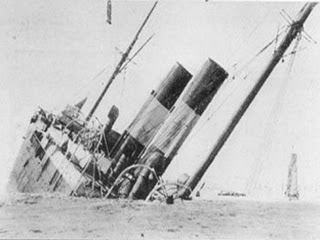 of the ship as she broke apart.
of the ship as she broke apart.
The Sirio was traveling from Spain to America in 1906, carrying the poorest of the poor from Spain as they headed for the USA in search of a better life.
She should have carried 610 passengers, but is said to have had more than 1000 on board, a bunk which should have held 1 child sleeping four, and the captain is known to have taken on board many extra passengers at 100 pesetas a head for the journey to America without declaring them on the passenger list.
For some reason which is still not clear, the captain chose to ignore the warning of the lighthouse and charts, taking a short cut between the islands where the waters concealed hidden rocks and hit a ridge. A massive explosion split the ship in two and it went down in two sections in deep water, either side of the ridge it had hit. The captain and his crew were the first to abandon ship, leaving the frightened passengers to fight for the few lifeboats, and only the efforts of local fishermen who mounted a rescue effort saved the lives of 580, with everyone else perishing when the boat went down
To date, no-one knows how many died that day, as no records were kept of the illegal passengers on board and no further action was taken against the captain who caused the deaths of so many through his recklessness and greed.
The final major historical event to take place here was the biggest naval battle of the Spanish Civil war in 1938, the battle of Cabo de Palos.
Habaneras Festival
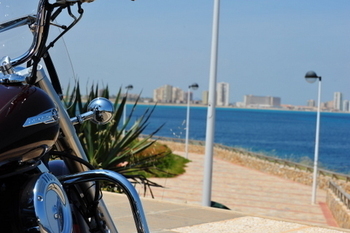 Each year in August a festival of Habaneras is held in Cabo de Palos, welcoming choirs from across the region to a celebration of choral music, with free concerts for the public to enjoy in the atmospheric setting of the lighthouse.
Each year in August a festival of Habaneras is held in Cabo de Palos, welcoming choirs from across the region to a celebration of choral music, with free concerts for the public to enjoy in the atmospheric setting of the lighthouse.
Although this festival was traditionally held by the lighhouse, it has also been held down by the church in the village of Cabo de Palos itself on occasions, so check in the Whats on section of the site around July when the programme is usually released.
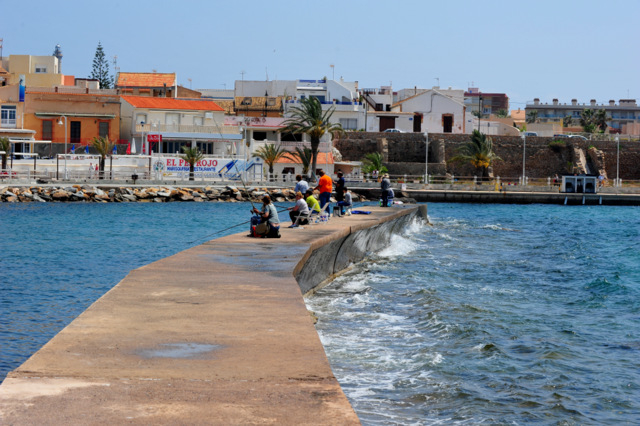
What else to do in Cabo de Palos
From the lighthouse back up to the mainland, the peninsula is fringed with small rocky inlets and sheltered beaches. The Cala Fria beaches are right next to the lighthouse, with good driveable access and parking, 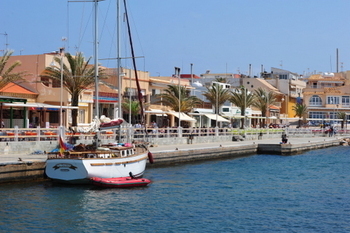 and offer outstanding snorkeling facilities. They are widely used by local dive schools for those making their first dives as the bay is shallow and sandy, yet fringed with rock formations harbouring an extensive range of marine life.
and offer outstanding snorkeling facilities. They are widely used by local dive schools for those making their first dives as the bay is shallow and sandy, yet fringed with rock formations harbouring an extensive range of marine life.
The islands surrounding the peninsula form part of the Islas Hormigas wildlife reserve and the Isla Grosa is a well renowned stop-off point for migrating birds, as well as being a sanctuary for wildlife.
Driving back down towards the mainland, youll find the marina. This is a lovely place to stroll on a summer evening, and is also a pleasant spot to sit and watch the world go by, with a steady stream of pleasure boats coming and going during the summer months or sunny weekends. A jetty is popular with local fishermen and 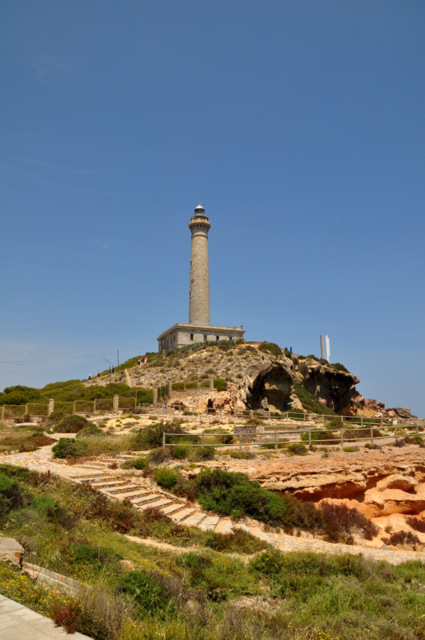 families and a number of bars offer superb people-watching opportunities, as well as being an ideal place to soak up the busy port atmosphere. The marina is still a working fishing port, so there are fishermen coming and going, and of course, the result of this is that a superb range of fresh fish dishes are available in neighbouring restaurants.
families and a number of bars offer superb people-watching opportunities, as well as being an ideal place to soak up the busy port atmosphere. The marina is still a working fishing port, so there are fishermen coming and going, and of course, the result of this is that a superb range of fresh fish dishes are available in neighbouring restaurants.
Practical points
Access: the walk up to the lighthouse is fairly steep, so is not easy for those of limited mobility or wheelchairs. The only toilet facilities are in nearby hostelries.
There is plenty of parking at the foot of the lighthouse.
Would we recommend it?
We had a lovely morning out, exploring the beaches, eating ice cream in the marina, walking up to the lighthouse, then enjoying an excellent menu del dia, although its also an excellent place for a walk on a summers evening when the heat has gone out of the day, and we were pleasantly surprised by the scenic, rocky bays which dotted this coastline.
Conclusion? Yes, absolutely.








